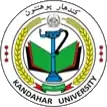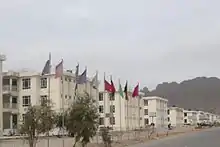Kandahar University
Kandahar University (Pashto: د کندهار پوهنتون)[3] is a government funded higher learning institution in Kandahar, Afghanistan. It is one of two universities in southern Afghanistan. Kandahar University (KU) was established in 1990, at a time when the People's Democratic Party of Afghanistan (PDPA) was in power under President Mohammad Najibullah. Tooryalai Wesa, who returned to the country after 13 years and is governor of Kandahar province, was the first chancellor of Kandahar University.
Pashto: د کندهار پوهنتون | |
 | |
| Type | Public |
|---|---|
| Established | 1990[1] |
| Chancellor | Dr. Abdul Wahid Waseeq |
| Vice-Chancellor | Sher Shah Rashad |
| Students | 9,000 (500 women)[2] |
| Location | , , |
| Website | kdru |
Kandahar University provides study in Computer Science, Medicine, Engineering, economics, journalism and communications, public administration and policy, law and political science, pharmacy, language and literature and Education. It has more than 9000 students including 500 girls in eleven faculties.[2] The university enrolls around 3000 students each year through an entrance exam directly under the control of the Afghan Ministry of Higher Education.[4]
Overview

Kandahar University was established in 1990 based on the national developing policy of the government in the education sector in the framework of the Ministry of Higher Education. At first it had only one faculty of agriculture. After that faculties of medicine, engineering, education, sharia law, economics and journalism were established in 1994, 2000, 2003, 2008, 2009 and 2012 correspondingly. In addition to that two faculties (Agricultural and Education) are established as a branch of Kandahar University in Helmand province. Currently, Kandahar University has around 9000 students and 270 full- and part-time professors. Out of 270 professors 100 have MSc and 3 has a PhD. The university has 1039 alumni from four faculties (agriculture, medicine, engineering and education). The university has night classes for students who are not able to attend during the day as well as in-service employees of public, private and NGOs.
Until 2003 the university did not have its own campus and was operating in a mobile form. It was got its current campus in 2003 which has the area of 93 hectares. The 13 buildings are mainly constructed for dormitory purposes (student housing facilities) which the university is providing, in addition to administration and academic purposes. KU has an agricultural research farm on the campus and a teaching hospital outside the campus which was transferred to the university from the Afghan National Army properties in Kandahar City at the request of the university and approval of President Hamid Karzai.
KU has established a center for IT which was supplied by NATO and university planned to connect it to optical fiber project. The university has 161 computers in 5 PC Labs for students’ use. The university does not have a proper central library due to the lack of infrastructure and instead of that has 8 small libraries in faculties and departments. There is no proper place of study for students and they have to manage it in their dorms or elsewhere which is difficult since each room is shared by 10 to 12 students. The curricula for different faculties are prepared considering the need of the country and global developments. The educational credit system is used in the faculties of medicine and education. Some basic labs are being prepared for carrying out some laboratory instruction in the faculties of education, agricultural, engineering and medicine.
The campus covers an area of more than 600,000 m2. It has 11 buildings, of which one is the Administration and Chancellor's office, four buildings for a hostel, one for each faculty and one for the Central Library. There is a separate girls' hostel. Other structures on the campus are the tomb of Allama Abdul Shakoor Rishad baba who was a writer, artist and poet of Afghanistan and a mosque located beside the university for attending the Eid prayers each year.
In 2008 the Canadian government built a 3-km perimeter of stone, brick and iron around the campus to address security concerns, which has been dubbed "the Great Wall of Kandahar". In 2012, with the assistance of the University of Arizona in the United States, Kandahar University began using solar energy for electricity.[2]
Gallery
 The Eidgah Jaami Jumat at Kandahar University
The Eidgah Jaami Jumat at Kandahar University Dean of Agriculture faculty (left) receives books of Soil Science
Dean of Agriculture faculty (left) receives books of Soil Science
See also
References
- 132 university students graduated
- "Kandahar University Goes Solar". November 3, 2012. Archived from the original on February 18, 2013. Retrieved 2012-11-05.
- "Home | KDRU". kdru.edu.af. Retrieved 2021-01-31.
- "Educatly". www.educatly.com. Retrieved 2021-02-01.
External links
| Wikimedia Commons has media related to Kandahar University. |